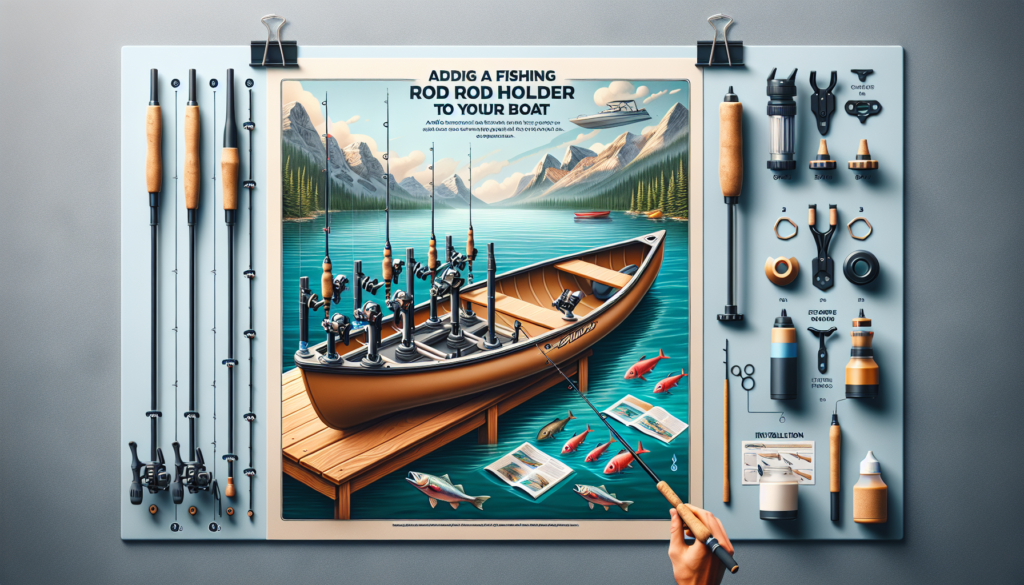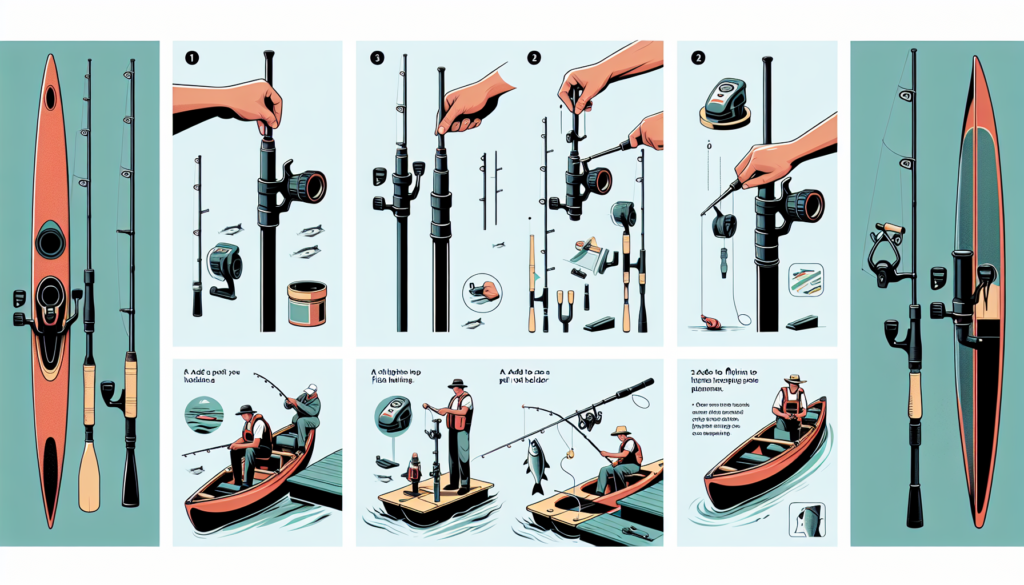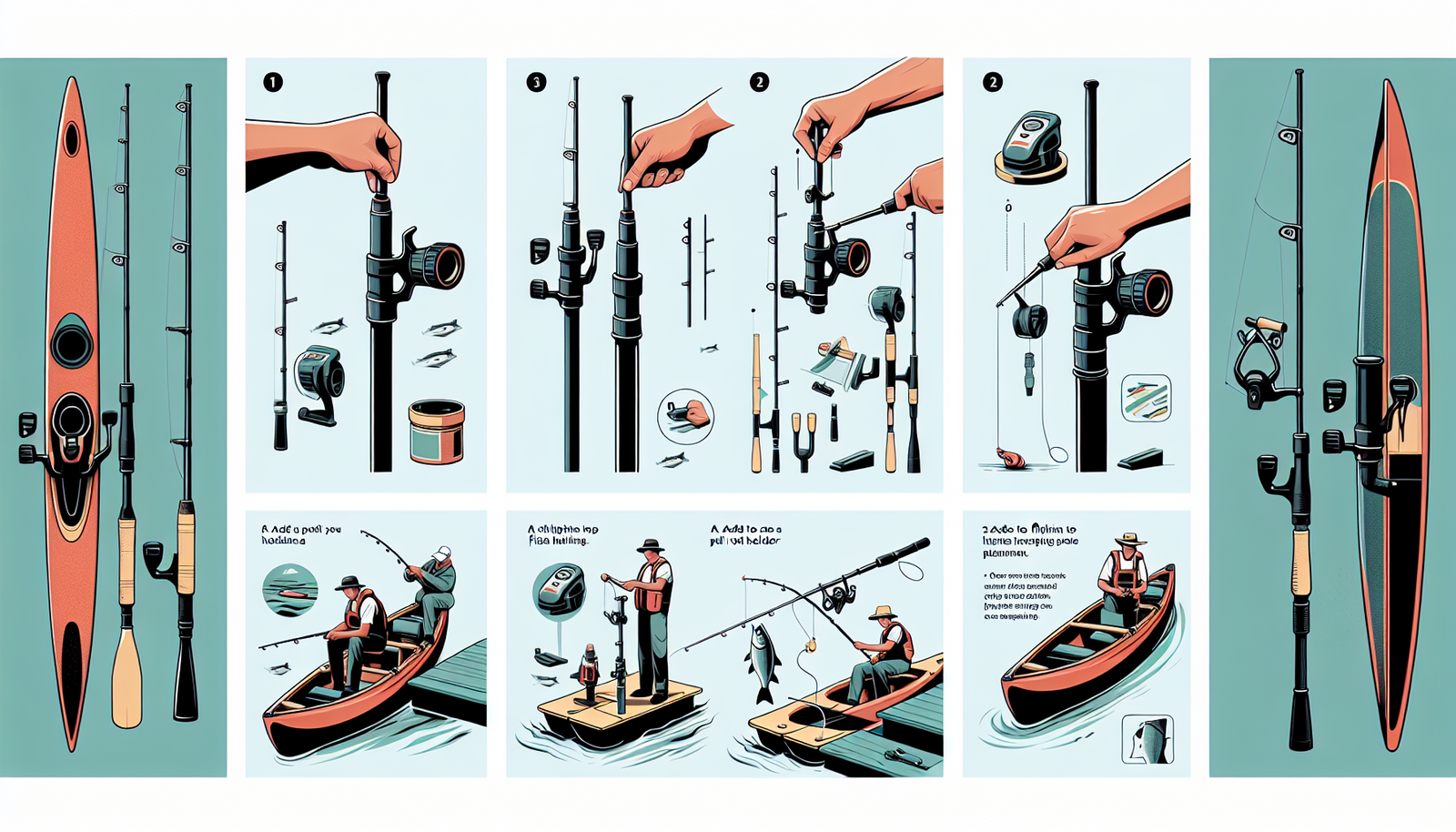So you’ve recently acquired a boat and you’re excited to cast your line and reel in a big catch. But there’s just one problem – you don’t have a fishing rod holder! Not to worry, because in this article, we’ll show you exactly how to add a fishing rod holder to your boat. Whether you’re a seasoned angler or a beginner looking to enhance your fishing experience, these simple steps will have you setting up your rod holder in no time. Say goodbye to awkwardly balancing your fishing rod or holding it in your hand all day. With our easy-to-follow instructions, you’ll be able to relax, sit back, and let the rod holder do the work while you enjoy a day on the water.

Choosing the Right Fishing Rod Holder
Types of Fishing Rod Holders
When it comes to choosing the right fishing rod holder for your boat, there are several types to consider. Each type has its own advantages and is designed to accommodate different fishing styles. Some common types of fishing rod holders include flush mount rod holders, adjustable rod holders, clamp-on rod holders, and rail-mounted rod holders. Flush mount rod holders are installed directly into the boat and provide a clean and seamless look. Adjustable rod holders allow you to change the angle and position of the rod, providing versatility during your fishing trips. Clamp-on rod holders are a great option if you don’t want to permanently install the holder, as they can be easily attached to different parts of your boat. Rail-mounted rod holders are designed to be attached to the boat’s railing and are a popular choice for boats with limited space. Consider your fishing style and boat setup to determine which type of fishing rod holder suits your needs best.
Considerations for Material
When choosing a fishing rod holder, the material it is made of is an important factor to consider. The most common materials used for fishing rod holders are stainless steel, aluminum, and plastic. Stainless steel rod holders are known for their durability and resistance to corrosion, making them a great choice for saltwater fishing. Aluminum rod holders are lightweight and offer good corrosion resistance as well. Plastic rod holders, on the other hand, are affordable and lightweight, making them a popular choice for anglers on a budget. Consider the type of water you will be fishing in, the weight of your fishing rods, and your budget when deciding on the material for your fishing rod holder.
Mounting Options
Another aspect to consider when choosing a fishing rod holder is the mounting option. There are various mounting options available, including flush mount, surface mount, and rail mount. Flush mount rod holders are installed directly into the boat, providing a seamless look. Surface mount rod holders are attached to the surface of the boat and are a good option if you don’t want to drill into your boat. Rail mount rod holders are designed to be attached to the boat’s railing and are a popular choice for boats with limited space. Consider the structure and design of your boat, as well as your personal preference, when deciding on the mounting option for your fishing rod holder.
Determining the Number of Rod Holders Needed
Factors to Consider
The number of fishing rod holders needed for your boat depends on several factors. First, consider the number of anglers you usually have on board. Each angler may want to have their own fishing rod holder for convenience. Additionally, think about the type of fishing you will be doing. If you plan on trolling multiple lines, you will need more rod holders to accommodate the number of rods in use. Finally, consider the size of your boat and the available space for rod holders. It’s important to have a sufficient number of rod holders without cluttering the boat or impeding movement.
Recommended Number of Rod Holders
As a general guideline, it is recommended to have at least two fishing rod holders on your boat. This allows for a balanced setup, ensuring that each angler has a place to secure their fishing rod. However, the number of rod holders needed may vary depending on your specific needs. For example, if you frequently fish with a large group or engage in trolling, you may need more rod holders to accommodate multiple lines. Assess your fishing style and the number of anglers you typically have on board to determine the recommended number of rod holders for your boat.
Measuring and Marking the Placement
Identifying an Ideal Location
Before installing your fishing rod holders, you need to identify an ideal location on your boat. Consider factors such as the layout of your boat, the fishing area, and accessibility. Choose a location that provides easy access to the fishing rods while still being out of the way to avoid any interference with other activities on the boat. Furthermore, consider the balance of the boat to ensure that the weight distribution is not compromised.
Spaced Placement
When determining the placement of your fishing rod holders, it’s important to have a well-spaced setup. This allows for easy maneuverability and prevents tangling of the fishing lines. Depending on the size of your boat, the fishing rod holders should be placed evenly along the gunwale or other suitable locations. Consider the length of your fishing rods and the space required to comfortably handle the rods when selecting the distance between each rod holder.
Marking the Placement
Once you have identified the ideal locations for your fishing rod holders, it’s time to mark the placement. Use a pencil or marker to mark the precise spot where each rod holder will be installed. Take into account any mounting holes or brackets that may come with your rod holders and mark accordingly. Double-check the markings to ensure accuracy before proceeding with the installation process.
Preparing the Boat for Installation
Cleaning the Area
Before installing the fishing rod holders, it’s important to clean the area where they will be mounted. Remove any dirt, debris, or residue that could interfere with the installation process. Use a mild cleaner and a soft cloth to wipe down the surface and ensure a clean and smooth surface for mounting.
Gathering the Necessary Tools and Equipment
Before beginning the installation process, gather all the necessary tools and equipment. Common tools needed for installing fishing rod holders include a drill, appropriate drill bits, screwdrivers, wrenches, and hardware provided with the rod holders. Refer to the manufacturer’s instructions for the specific tools and equipment required for your rod holders. Having everything prepared in advance will make the installation process smoother and more efficient.

Installing the Fishing Rod Holder
Choosing the Appropriate Mounting Method
Before installing the fishing rod holder, decide on the appropriate mounting method for your boat and rod holder type. Refer to the manufacturer’s instructions for the recommended mounting method and follow the instructions accordingly. Whether it’s drilling holes for a flush mount, attaching clamps for a clamp-on holder, or using brackets for a rail mount, ensure that you choose the method that will provide the most secure and stable installation for your fishing rod holder.
Step-by-Step Installation Process
- Begin by positioning the fishing rod holder in the marked location on your boat.
- If necessary, use a drill to create pilot holes for the mounting screws or bolts.
- Attach the holder to the boat using the provided hardware, making sure it is securely fastened.
- Repeat the process for each fishing rod holder, ensuring the proper spacing and alignment between them.
- Double-check the tightness of the screws or bolts to ensure a stable installation.
Securing the Holder
Once you have installed the fishing rod holder, it is important to ensure that it is securely fastened and stable. Give the holder a gentle shake to test its stability and make any necessary adjustments or re-tighten screws as needed. A secure and stable fishing rod holder will provide a reliable and safe place to store your fishing rods while out on the water.
Ensuring Stability and Durability
Checking the Holder’s Stability
After installing the fishing rod holder, it’s important to periodically check its stability. Regularly inspect the holder for any signs of loosening or damage. Give the rod holder a gentle shake to ensure it remains securely fastened to your boat. If you notice any issues with stability, tighten the screws or bolts, or make any necessary adjustments to ensure the holder remains stable during use.
Reinforcing the Installation
To ensure long-term stability and durability, consider reinforcing the installation of your fishing rod holder. Depending on the type of boat and fishing rod holder, you can use additional support brackets, adhesive sealants, or backing plates to provide extra reinforcement. This will help distribute the weight and pressure more evenly, reducing the strain on the holder and preventing damage over time.
Quality Assurance Measures
Before heading out on the water, it’s always a good idea to perform quality assurance measures on your fishing rod holder installation. Check all screws, bolts, and fittings to ensure they are securely fastened and in good condition. Look for any signs of wear or damage, such as rust or cracks, and address them promptly. Regularly inspecting and maintaining your fishing rod holder will ensure its long-term stability and durability.

Considerations for Boat Compatibility
Assessing Boat Structure
Before installing a fishing rod holder, it’s important to assess the structure of your boat. Different boats have different characteristics and may require specific considerations when installing rod holders. Consider the material and thickness of the boat’s hull or railing to ensure that the fishing rod holder can be properly installed and provide a secure fit. Consult your boat’s manufacturer or an experienced professional for guidance if you are unsure about the compatibility of a rod holder with your boat’s structure.
Compatibility with Boat Design
In addition to the boat’s structure, consider the overall design of your boat when selecting a fishing rod holder. Some boats have specific mounting locations or built-in features that can accommodate certain types of rod holders more effectively. Take into account any existing fixtures, such as handrails or storage compartments, and choose a rod holder that will seamlessly fit with your boat’s design. This will not only enhance the functionality of the rod holder but also maintain the aesthetic appeal of your boat.
Weight Distribution
Another important consideration for boat compatibility is the weight distribution. When installing fishing rod holders, it’s essential to maintain a balanced weight distribution throughout the boat. Uneven weight distribution can affect the boat’s stability and handling. Consider the weight of the rod holders themselves and the fishing rods that will be placed in them. Distribute the rod holders evenly along the boat’s gunwale or other suitable locations to ensure a balanced setup and optimal performance.
Maintaining and Preserving the Rod Holder
Cleaning and Washing
To maintain the functionality and appearance of your fishing rod holder, regular cleaning and washing are essential. After each fishing trip, rinse the rod holder with fresh water to remove any salt, dirt, or debris. Use a mild soap and a soft cloth or sponge to gently clean the holder, paying attention to any crevices or hard-to-reach areas. Avoid using harsh chemicals or abrasive materials that may damage the holder’s surface or coating. Regular cleaning will help prevent corrosion and keep your fishing rod holder in good condition.
Applying Lubrication
To ensure smooth operation and prevent rust or corrosion, it’s recommended to apply lubrication to the moving parts of your fishing rod holder. Use an appropriate marine-grade lubricant or silicone spray to lubricate any pivot points, hinges, or adjustable mechanisms. Apply the lubrication as directed by the manufacturer, taking care not to overapply. Proper lubrication will help maintain the functionality of the rod holder and extend its lifespan.
Inspection and Maintenance
Regular inspection and maintenance are crucial for the long-term performance of your fishing rod holder. Periodically inspect the holder for any signs of damage, wear, or corrosion. Check the screws, bolts, and fittings to ensure they are securely fastened. Look for any stress cracks, bent or broken parts, or signs of rust. Address any issues promptly by tightening screws, replacing damaged parts, or applying protective coatings if needed. By properly inspecting and maintaining your fishing rod holder, you can prolong its lifespan and ensure reliable performance.

Proper Storage of Fishing Rods
Securing Rods During Transport
When transporting your boat, it’s important to secure your fishing rods properly to prevent any damage. Use rod straps or bungee cords to secure the rods in the fishing rod holder or other designated rod storage areas. Make sure the rods are positioned securely and the straps are tightened to prevent any movement during transport. This will help protect your fishing rods from potential impact or vibration damage.
Storing Rods on the Boat
When your boat is not in use, it’s important to store your fishing rods properly to maintain their condition. If your boat has designated rod storage compartments or racks, use them to store your rods securely. Ensure that the rods are not at risk of falling or shifting during storage. If your boat does not have built-in rod storage, consider using rod holders or vertical rod racks that can be mounted securely on the boat’s interior or exterior. Storing your fishing rods properly will protect them from damage and prolong their lifespan.
Protection from Weather and External Factors
To further protect your fishing rods from weather and external factors, consider using rod covers or sleeves. These protective covers provide an additional layer of defense against UV rays, rain, dust, and other elements that could potentially damage your rods. Additionally, if you plan on leaving your fishing rods on the boat for an extended period, consider using rod holders with integrated rod protectors or covers. These specialized rod holders provide extra protection for your rods, keeping them secure and shielded from the elements.
Additional Accessories and Features
Rod Holder Extensions
If you need additional reach or flexibility with your fishing rod holder, consider using rod holder extensions. These accessories allow you to extend the height or length of the rod holder, providing a better angle and positioning for your fishing rod. Rod holder extensions can be particularly useful if you have tall gunwales on your boat or if you prefer fishing with longer rods. Choose extensions that are compatible with your rod holder type and provide a sturdy and secure attachment.
Removable vs. Permanent Attachments
When selecting a fishing rod holder, consider whether you want a removable or permanent attachment. Removable rod holders are versatile and allow you to easily swap them between different boats or positions on your boat. They are typically attached using clamps or suction cups and can be easily removed when not in use. Permanent attachments, on the other hand, provide a more secure and stable installation. They are usually mounted directly onto the boat’s surface or railing using screws or bolts. Consider your specific needs and preferences to determine whether a removable or permanent attachment is the right choice for you.
Rod Holders with Integrated Features
Some fishing rod holders come with integrated features that can enhance your fishing experience. These features can include additional storage compartments, cup holders, tool holders, or even fishfinder mounts. Integrated features can help declutter your boat and provide convenient storage for essential fishing gear. Consider the additional features offered by certain rod holders and choose one that aligns with your specific needs and preferences. Remember to prioritize functionality and ensure that the additional features do not compromise the quality and stability of the rod holder itself.
By following these guidelines and considering the various factors involved in choosing, installing, and maintaining a fishing rod holder, you can enhance your fishing experience and ensure the safety and convenience of storing your fishing rods on your boat. Remember to always refer to the manufacturer’s instructions for specific guidance on installing and maintaining your chosen fishing rod holder. With the right fishing rod holder in place, you can focus on enjoying your time on the water and reel in those big catches with ease. Happy fishing!


